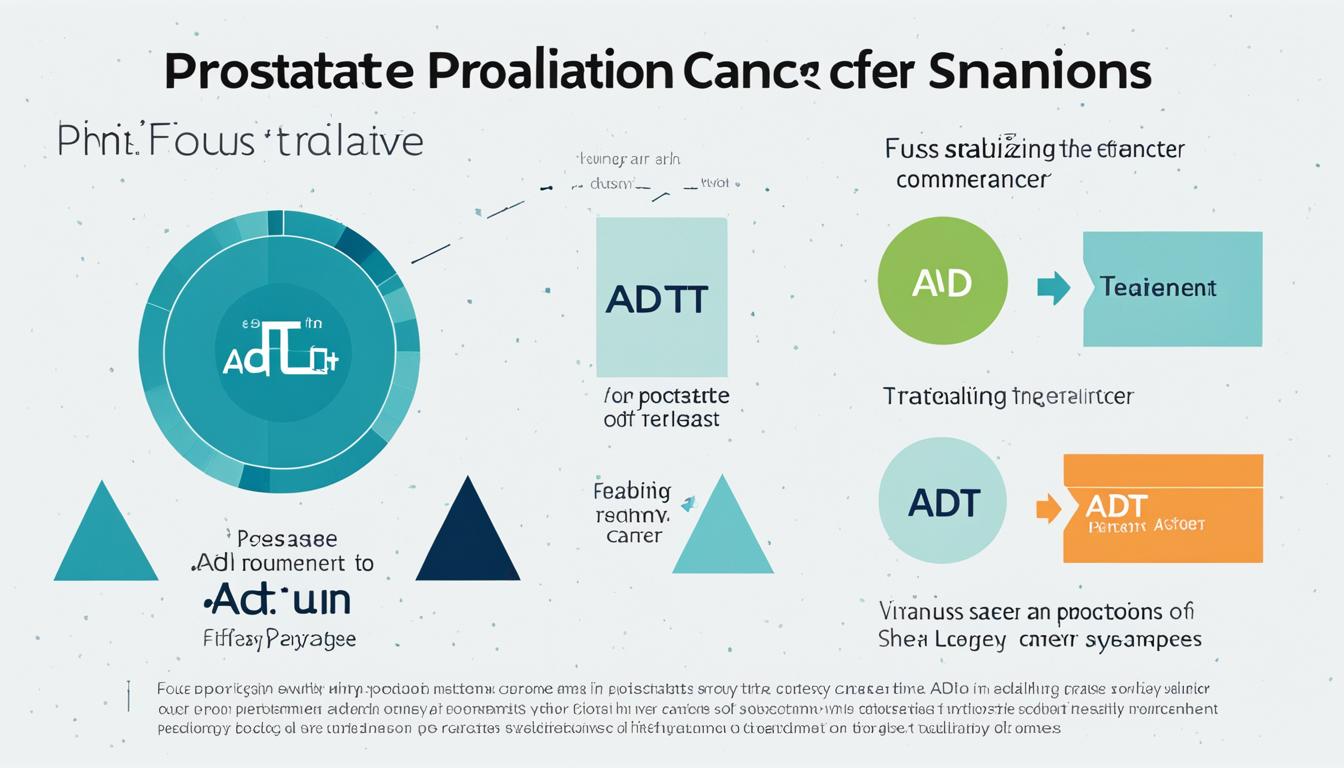When it comes to treating prostate cancer, androgen deprivation therapy (ADT) has proven to be a valuable weapon in our arsenal. ADT, a hormone therapy that regulates androgen levels in the body, offers significant benefits for patients, particularly those with high-risk cases. However, an important consideration in the effectiveness of ADT lies in its duration.
Multiple studies have examined the optimal duration of ADT in combination with radiotherapy for prostate cancer treatment. Understanding the recommended duration of ADT is crucial in optimizing treatment strategies and improving patient outcomes.
So, how long does ADT work for prostate cancer? Let’s delve into the role of ADT in prostate cancer treatment and explore the insights into its duration.
Key Takeaways:
- The duration of androgen deprivation therapy (ADT) is a crucial factor in its effectiveness against prostate cancer.
- ADT is a hormone therapy that reduces the levels of androgens in the body, targeting the growth and development of prostate cancer cells.
- The optimal duration of ADT varies depending on the stage and aggressiveness of the cancer.
- ADT combined with radiotherapy has shown promising results in improving outcomes for high-risk prostate cancer patients.
- Determining the optimal duration of ADT requires considering the type of radiotherapy used and individual patient characteristics.
The Role of ADT in Prostate Cancer Treatment
Androgen deprivation therapy (ADT) is a hormone therapy that plays a crucial role in the treatment of prostate cancer. By targeting and reducing the levels of androgens, such as testosterone, in the body, ADT aims to slow down the progression of prostate cancer and improve patient outcomes.
Androgens, like testosterone, play a significant role in the growth and development of prostate cancer cells. By suppressing androgen levels, ADT disrupts the cancer cells’ ability to thrive and spread, ultimately inhibiting the disease’s progression.
The duration of ADT treatment varies depending on the stage and aggressiveness of the cancer. In more advanced cases, longer durations of ADT may be necessary to achieve optimal results. The treatment duration is determined based on a thorough assessment of the patient’s cancer characteristics and individualized treatment planning.
To provide a comprehensive understanding of the treatment timeline, let’s take a closer look at the different factors that influence the duration of ADT for prostate cancer treatment:
1. Stage and Aggressiveness of Prostate Cancer
The stage and aggressiveness of prostate cancer are important determining factors in the duration of ADT treatment. In high-risk or advanced cases, where the cancer has spread beyond the prostate gland, longer durations of ADT may be recommended to effectively manage and control the disease.
2. Treatment Goals and Response
The treatment goals and the response to ADT play a crucial role in determining the duration of therapy. The primary objective is to achieve a favorable response, such as tumor shrinkage or stabilization, while minimizing the side effects associated with ADT. The treatment duration may be adjusted based on the patient’s individual response and the need to balance effectiveness and quality of life.
3. Combination with Other Therapies
ADT is often used in combination with other treatments, such as radiotherapy or surgery, to enhance its effectiveness and improve patient outcomes. The duration of ADT may be influenced by the overall treatment plan and the specific sequence and timing of therapies.
4. Patient-Specific Considerations
Individual patient characteristics and preferences also play a role in determining the duration of ADT treatment. Factors such as age, overall health, and the patient’s ability to tolerate ADT side effects are taken into account when tailoring the treatment plan to each patient’s unique needs.
Overall, the duration of ADT treatment for prostate cancer is carefully evaluated and individualized based on various factors. It is essential for healthcare professionals to assess each patient’s specific situation and develop a treatment plan that optimizes both the effectiveness and the quality of life for the individual.
**Table: Comparison of Recommended ADT Durations for Prostate Cancer Treatment**
| Stage of Prostate Cancer | Recommended ADT Duration |
|————————-|————————-|
| Early-stage (localized) | 6 months to 2 years |
| Intermediate-risk | 2 to 3 years |
| High-risk/advanced | 2 to 3 years (or longer)|
Note: The recommended ADT durations are subject to individual patient characteristics and treatment planning. They may vary based on clinical judgment and the specific needs of each patient.
Optimizing ADT Duration with Radiotherapy
The use of androgen deprivation therapy (ADT) in conjunction with radiotherapy has shown promising results in improving outcomes for high-risk prostate cancer patients. However, determining the optimal duration of ADT in combination with radiotherapy remains a topic of ongoing research and discussion.
Several randomized clinical trials have investigated the impact of ADT duration on distant metastasis-free survival (DMFS) and overall survival (OS) in patients undergoing radiotherapy. These studies have demonstrated that the minimum duration of ADT necessary to achieve optimal outcomes may vary depending on the type of radiotherapy used and individual patient characteristics.
According to a study comparing immediate versus deferred treatment for advanced prostatic cancer, the addition of ADT to radiotherapy has been shown to be effective in improving patient outcomes. However, the ideal duration of ADT in this context is still uncertain and requires further investigation.
“The optimal duration of ADT in conjunction with radiotherapy remains a subject of ongoing research. While the addition of ADT has shown positive results, we still need to determine the most effective duration for maximizing patient outcomes.”
It is important to note that the decision regarding ADT duration should be individualized based on the specific type of radiotherapy being utilized and the unique characteristics of each patient. The success of treatment relies on carefully considering these factors to tailor an optimal treatment strategy.
Summary of ADT Treatment Duration Studies
| Study | ADT Duration | Radiotherapy Type | Outcome Measures |
|---|---|---|---|
| Maximum androgen blockade in advanced prostate cancer | Varies based on study design | External beam radiotherapy | Distant metastasis-free survival (DMFS), overall survival (OS) |
| Immediate vs deferred treatment for advanced prostatic cancer | Still being investigated | Various | Optimal ADT duration and patient outcomes |
As shown in the table above, different studies have explored the relationship between ADT duration, radiotherapy type, and outcome measures such as DMFS and OS. These findings highlight the need for personalized treatment approaches to ensure the best possible outcomes for prostate cancer patients.

Continue reading: In the next section, we delve further into determining the optimal duration of ADT in prostate cancer treatment.
Determining the Optimal ADT Duration
Natural cubic spline analysis has been used to determine the minimum ADT duration thresholds for optimal effect on distant metastasis-free survival (DMFS) in patients receiving external beam radiotherapy or brachytherapy boost. Research findings from a multicenter retrospective study (Third source) suggest that the recommended minimum ADT duration for high-dose external beam radiotherapy alone is more than 18 months. However, for patients undergoing external beam radiotherapy with a brachytherapy boost, the optimal duration may be 18 months or possibly shorter.
These insights highlight the significance of individualizing treatment strategies based on the specific type of radiotherapy and the unique characteristics of each patient. By adopting a personalized approach to ADT duration, healthcare professionals can maximize treatment efficacy and improve patient outcomes.

| ADT Duration | Radiotherapy Type | Optimal Effect on DMFS |
|---|---|---|
| More than 18 months | High-dose external beam radiotherapy alone | Recommended minimum duration |
| 18 months or possibly shorter | External beam radiotherapy with a brachytherapy boost | Optimal duration |
By understanding and implementing the appropriate ADT duration based on the specific treatment approach, healthcare professionals can enhance the therapeutic impact of ADT and strive towards better outcomes for patients with prostate cancer.
Conclusion
Determining the optimal duration of ADT in prostate cancer treatment is a complex decision that requires careful consideration of various factors. These factors include the type of radiotherapy utilized and individual patient characteristics. While longer ADT durations may be beneficial in certain cases, shorter durations combined with specific types of radiotherapy can also yield positive outcomes.
It is crucial for healthcare professionals to evaluate each patient’s unique situation and tailor their treatment plan accordingly. By personalizing the duration of ADT, we can effectively manage the patient’s prostate cancer and optimize treatment outcomes.
Further research is needed to refine the recommendations for ADT duration in advanced prostate cancer. This research will contribute to improving the overall management of prostate cancer and enhancing the effectiveness of ADT as a treatment option. Together, we can continue to advance our understanding of ADT and its role in combating prostate cancer.
FAQ
How long does ADT work for prostate cancer?
The duration of ADT for prostate cancer treatment varies depending on the stage and aggressiveness of the cancer. In advanced cases, longer durations of ADT may be necessary to achieve optimal results.
What is the role of ADT in prostate cancer treatment?
ADT, or androgen deprivation therapy, is a hormone therapy that targets and reduces the levels of androgens, such as testosterone, in the body. It aims to slow down the progression of prostate cancer and improve patient outcomes.
What is the optimal duration of ADT in conjunction with radiotherapy?
The optimal duration of ADT in conjunction with radiotherapy remains unclear and may vary depending on the type of radiotherapy used and individual patient characteristics. Further research is needed to refine the recommendations for ADT duration.
How can ADT duration be optimized with radiotherapy?
Determining the optimal ADT duration with radiotherapy requires consideration of various factors, including the type of radiotherapy utilized and individual patient characteristics. Individualized treatment strategies can be tailored based on specific patient situations.
How can the optimal ADT duration be determined?
The optimal ADT duration can be determined through natural cubic spline analysis, taking into account the type of radiotherapy and individual patient characteristics. Research studies have identified minimum ADT duration thresholds for optimal effect on distant metastasis-free survival (DMFS) in patients receiving radiotherapy.
How Does ADT Affect White Blood Cell Count in Prostate Cancer Patients?
Prostate cancer and white blood cells are closely related, as ADT (androgen deprivation therapy) is known to affect the white blood cell count in patients. This treatment can lead to a decrease in the body’s production of white blood cells, increasing the risk of infections and impacting overall immune system health for prostate cancer patients.



